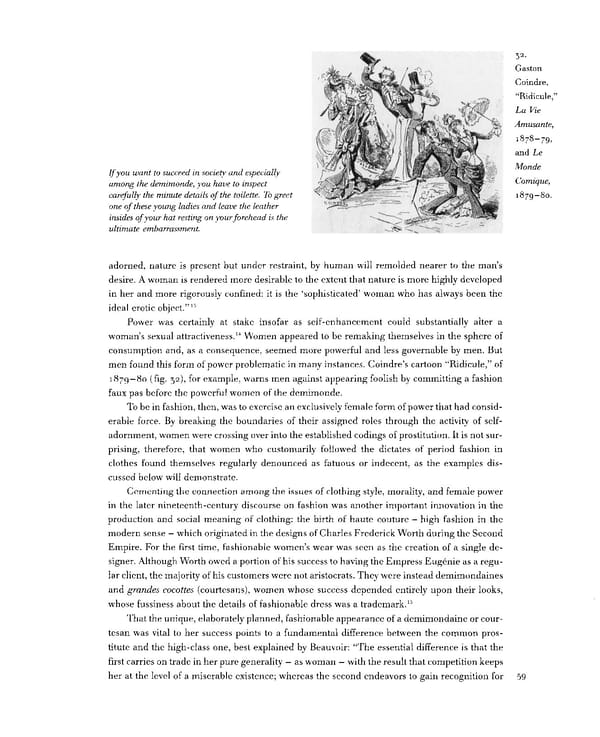2 3 - Gaston Coindre, "Ridicule," La Vie Amusante, 1878-79, and Le If you want to succeed in society and especially Monde among the demimonde, you have to inspect Comique, carefully the minute details of the toilette. To greet 1879-80. one of these young ladies and leave the leather insides of your hat resting on your forehead is the ultimate embarrassment adorned, nature is present but under restraint, by human will remolded nearer to the man's desire. A woman is rendered more desirable to the extent that nature is more highly developed in her and more rigorously confined: it is the 'sophisticated' woman who has always been the ideal erotic object."13 Power was certainly at stake insofar as self-enhancement could substantially alter a 14 woman's sexual attractiveness. Women appeared to be remaking themselves in the sphere of consumption and, as a consequence, seemed more powerful and less governable by men. But men found this form of power problematic in many instances. Coindre's cartoon "Ridicule," of 1879-80 (fig. 32), for example, warns men against appearing foolish by committing a fashion faux pas before the powerful women of the demimonde. To be in fashion, then, was to exercise an exclusively female form of power that had consid- erable force. By breaking the boundaries of their assigned roles through the activity of self- adornment, women were crossing over into the established codings of prostitution. It is not sur- prising, therefore, that women who customarily followed the dictates of period fashion in clothes found themselves regularly denounced as fatuous or indecent, as the examples dis- cussed below will demonstrate. Cementing the connection among the issues of clothing style, morality, and female power in the later nineteenth-century discourse on fashion was another important innovation in the production and social meaning of clothing: the birth of haute couture — high fashion in the modern sense — which originated in the designs of Charles Frederick Worth during the Second Empire. For the first time, fashionable women's wear was seen as the creation of a single de- signer. Although Worth owed a portion of his success to having the Empress Eugenie as a regu- lar client, the majority of his customers were not aristocrats. They were instead demimondaines and grandes cocottes (courtesans), women whose success depended entirely upon their looks, 15 whose fussiness about the details of fashionable dress was a trademark. That the unique, elaborately planned, fashionable appearance of a demimondaine or cour- tesan was vital to her success points to a fundamental difference between the common pros- titute and the high-class one, best explained by Beauvoir: "The essential difference is that the first carries on trade in her pure generality - as woman - with the result that competition keeps her at the level of a miserable existence; whereas the second endeavors to gain recognition for 59
 Prostitution & Impressionists Page 79 Page 81
Prostitution & Impressionists Page 79 Page 81